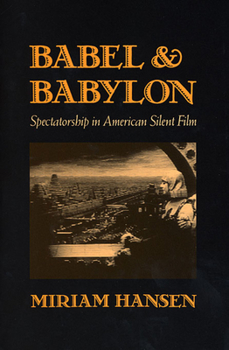Babel and Babylon: Spectatorship in American Silent Film
Select Format
Select Condition 
Book Overview
Although cinema was invented in the mid-1890s, it was a decade more before the concept of a "film spectator" emerged. As the cinema began to separate itself from the commercial entertainments in whose context films initially had been shown--vaudeville, dime museums, fairgrounds--a particular concept of its spectator was developed on the level of film style, as a means of predicting the reception of films on a mass scale. In Babel and Babylon , Miriam Hansen offers an original perspective on American film by tying the emergence of spectatorship to the historical transformation of the public sphere. Hansen builds a critical framework for understanding the cultural formation of spectatorship, drawing on the Frankfurt School's debates on mass culture and the public sphere. Focusing on exemplary moments in the American silent era, she explains how the concept of the spectator evolved as a crucial part of the classical Hollywood paradigm--as one of the new industry's strategies to integrate ethnically, socially, and sexually differentiated audiences into a modern culture of consumption. In this process, Hansen argues, the cinema might also have provided the conditions of an alternative public sphere for particular social groups, such as recent immigrants and women, by furnishing an intersubjective context in which they could recognize fragments of their own experience. After tracing the emergence of spectatorship as an institution, Hansen pursues the question of reception through detailed readings of a single film, D. W. Griffith's Intolerance (1916), and of the cult surrounding a single star, Rudolph Valentino. In each case the classical construction of spectatorship is complicated by factors of gender and sexuality, crystallizing around the fear and desire of the female consumer. Babel and Babylon recasts the debate on early American cinema--and by implication on American film as a whole. It is a model study in the field of cinema studies, mediating the concerns of recent film theory with those of recent film history.
Format:Paperback
Language:English
ISBN:0674058313
ISBN13:9780674058316
Release Date:March 1994
Publisher:Harvard University Press
Length:390 Pages
Weight:1.12 lbs.
Dimensions:0.9" x 6.3" x 9.3"
Customer Reviews
3 ratings
Not just relevant to film
Published by Thriftbooks.com User , 17 years ago
As other reviewers have noted, this study is a terrific analysis of how early film could be an open, more interactive medium. But it is valuable for more than its contribution to the history of film. Hansen combines her study of the history of film with two other areas--1) empirical study of the reception of early film (the opportunities for collective sense-making by populations such as women and new immigrant groups), and 2) theoretical study of the way film changes our ideas about the public sphere. It is the methodological richness of this book that makes it such a powerful work. Readers are offered astute, inventive close readings of films, informed discussions about historical reception, and cutting-edge ideas about what a mass-culture medium like film might mean for our ideas of public reason.
Invaluable
Published by Thriftbooks.com User , 22 years ago
This is one of the best books on early cinema written by one of the best film theorists/historians on spectatorship.
Superb tour-de-force of early cinema
Published by Thriftbooks.com User , 23 years ago
While some of the academic language may not be familiar to all readers, this is a superb account of early cinema that bridges the divide between film history and film theory. Hansen's argument that early cinema possessed a fundamentally different model of spectatorship--an interactive and collective one--is lucidly articulated, in addition to being wholly provocative for understanding what it means to go to the movies now. This book altered my sense of my own viewing and moviegoing practices today. An excellent book that discusses film in new ways, Babel and Babylon is both an absorbing and a fascinating reading experience.





